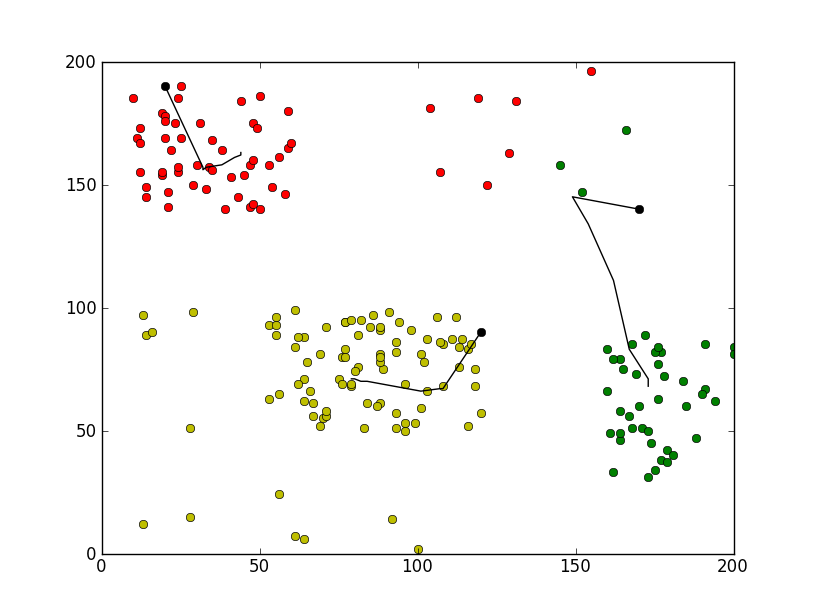本文实例讲述了Python聚类算法之基本K均值运算技巧。分享给大家供大家参考,具体如下:
基本K均值 :选择 K 个初始质心,其中 K 是用户指定的参数,即所期望的簇的个数。每次循环中,每个点被指派到最近的质心,指派到同一个质心的点集构成一个。然后,根据指派到簇的点,更新每个簇的质心。重复指派和更新操作,直到质心不发生明显的变化。
# scoding=utf-8
import pylab as pl
points = [[int(eachpoint.split("#")[0]), int(eachpoint.split("#")[1])] for eachpoint in open("points","r")]
# 指定三个初始质心
currentCenter1 = [20,190]; currentCenter2 = [120,90]; currentCenter3 = [170,140]
pl.plot([currentCenter1[0]], [currentCenter1[1]],'ok')
pl.plot([currentCenter2[0]], [currentCenter2[1]],'ok')
pl.plot([currentCenter3[0]], [currentCenter3[1]],'ok')
# 记录每次迭代后每个簇的质心的更新轨迹
center1 = [currentCenter1]; center2 = [currentCenter2]; center3 = [currentCenter3]
# 三个簇
group1 = []; group2 = []; group3 = []
for runtime in range(50):
group1 = []; group2 = []; group3 = []
for eachpoint in points:
# 计算每个点到三个质心的距离
distance1 = pow(abs(eachpoint[0]-currentCenter1[0]),2) + pow(abs(eachpoint[1]-currentCenter1[1]),2)
distance2 = pow(abs(eachpoint[0]-currentCenter2[0]),2) + pow(abs(eachpoint[1]-currentCenter2[1]),2)
distance3 = pow(abs(eachpoint[0]-currentCenter3[0]),2) + pow(abs(eachpoint[1]-currentCenter3[1]),2)
# 将该点指派到离它最近的质心所在的簇
mindis = min(distance1,distance2,distance3)
if(mindis == distance1):
group1.append(eachpoint)
elif(mindis == distance2):
group2.append(eachpoint)
else:
group3.append(eachpoint)
# 指派完所有的点后,更新每个簇的质心
currentCenter1 = [sum([eachpoint[0] for eachpoint in group1])/len(group1),sum([eachpoint[1] for eachpoint in group1])/len(group1)]
currentCenter2 = [sum([eachpoint[0] for eachpoint in group2])/len(group2),sum([eachpoint[1] for eachpoint in group2])/len(group2)]
currentCenter3 = [sum([eachpoint[0] for eachpoint in group3])/len(group3),sum([eachpoint[1] for eachpoint in group3])/len(group3)]
# 记录该次对质心的更新
center1.append(currentCenter1)
center2.append(currentCenter2)
center3.append(currentCenter3)
# 打印所有的点,用颜色标识该点所属的簇
pl.plot([eachpoint[0] for eachpoint in group1], [eachpoint[1] for eachpoint in group1], 'or')
pl.plot([eachpoint[0] for eachpoint in group2], [eachpoint[1] for eachpoint in group2], 'oy')
pl.plot([eachpoint[0] for eachpoint in group3], [eachpoint[1] for eachpoint in group3], 'og')
# 打印每个簇的质心的更新轨迹
for center in [center1,center2,center3]:
pl.plot([eachcenter[0] for eachcenter in center], [eachcenter[1] for eachcenter in center],'k')
pl.show()
运行效果截图如下:

希望本文所述对大家Python程序设计有所帮助。
 How are arrays used in scientific computing with Python?Apr 25, 2025 am 12:28 AM
How are arrays used in scientific computing with Python?Apr 25, 2025 am 12:28 AMArraysinPython,especiallyviaNumPy,arecrucialinscientificcomputingfortheirefficiencyandversatility.1)Theyareusedfornumericaloperations,dataanalysis,andmachinelearning.2)NumPy'simplementationinCensuresfasteroperationsthanPythonlists.3)Arraysenablequick
 How do you handle different Python versions on the same system?Apr 25, 2025 am 12:24 AM
How do you handle different Python versions on the same system?Apr 25, 2025 am 12:24 AMYou can manage different Python versions by using pyenv, venv and Anaconda. 1) Use pyenv to manage multiple Python versions: install pyenv, set global and local versions. 2) Use venv to create a virtual environment to isolate project dependencies. 3) Use Anaconda to manage Python versions in your data science project. 4) Keep the system Python for system-level tasks. Through these tools and strategies, you can effectively manage different versions of Python to ensure the smooth running of the project.
 What are some advantages of using NumPy arrays over standard Python arrays?Apr 25, 2025 am 12:21 AM
What are some advantages of using NumPy arrays over standard Python arrays?Apr 25, 2025 am 12:21 AMNumPyarrayshaveseveraladvantagesoverstandardPythonarrays:1)TheyaremuchfasterduetoC-basedimplementation,2)Theyaremorememory-efficient,especiallywithlargedatasets,and3)Theyofferoptimized,vectorizedfunctionsformathematicalandstatisticaloperations,making
 How does the homogenous nature of arrays affect performance?Apr 25, 2025 am 12:13 AM
How does the homogenous nature of arrays affect performance?Apr 25, 2025 am 12:13 AMThe impact of homogeneity of arrays on performance is dual: 1) Homogeneity allows the compiler to optimize memory access and improve performance; 2) but limits type diversity, which may lead to inefficiency. In short, choosing the right data structure is crucial.
 What are some best practices for writing executable Python scripts?Apr 25, 2025 am 12:11 AM
What are some best practices for writing executable Python scripts?Apr 25, 2025 am 12:11 AMTocraftexecutablePythonscripts,followthesebestpractices:1)Addashebangline(#!/usr/bin/envpython3)tomakethescriptexecutable.2)Setpermissionswithchmod xyour_script.py.3)Organizewithacleardocstringanduseifname=="__main__":formainfunctionality.4
 How do NumPy arrays differ from the arrays created using the array module?Apr 24, 2025 pm 03:53 PM
How do NumPy arrays differ from the arrays created using the array module?Apr 24, 2025 pm 03:53 PMNumPyarraysarebetterfornumericaloperationsandmulti-dimensionaldata,whilethearraymoduleissuitableforbasic,memory-efficientarrays.1)NumPyexcelsinperformanceandfunctionalityforlargedatasetsandcomplexoperations.2)Thearraymoduleismorememory-efficientandfa
 How does the use of NumPy arrays compare to using the array module arrays in Python?Apr 24, 2025 pm 03:49 PM
How does the use of NumPy arrays compare to using the array module arrays in Python?Apr 24, 2025 pm 03:49 PMNumPyarraysarebetterforheavynumericalcomputing,whilethearraymoduleismoresuitableformemory-constrainedprojectswithsimpledatatypes.1)NumPyarraysofferversatilityandperformanceforlargedatasetsandcomplexoperations.2)Thearraymoduleislightweightandmemory-ef
 How does the ctypes module relate to arrays in Python?Apr 24, 2025 pm 03:45 PM
How does the ctypes module relate to arrays in Python?Apr 24, 2025 pm 03:45 PMctypesallowscreatingandmanipulatingC-stylearraysinPython.1)UsectypestointerfacewithClibrariesforperformance.2)CreateC-stylearraysfornumericalcomputations.3)PassarraystoCfunctionsforefficientoperations.However,becautiousofmemorymanagement,performanceo


Hot AI Tools

Undresser.AI Undress
AI-powered app for creating realistic nude photos

AI Clothes Remover
Online AI tool for removing clothes from photos.

Undress AI Tool
Undress images for free

Clothoff.io
AI clothes remover

Video Face Swap
Swap faces in any video effortlessly with our completely free AI face swap tool!

Hot Article

Hot Tools

SAP NetWeaver Server Adapter for Eclipse
Integrate Eclipse with SAP NetWeaver application server.

DVWA
Damn Vulnerable Web App (DVWA) is a PHP/MySQL web application that is very vulnerable. Its main goals are to be an aid for security professionals to test their skills and tools in a legal environment, to help web developers better understand the process of securing web applications, and to help teachers/students teach/learn in a classroom environment Web application security. The goal of DVWA is to practice some of the most common web vulnerabilities through a simple and straightforward interface, with varying degrees of difficulty. Please note that this software

EditPlus Chinese cracked version
Small size, syntax highlighting, does not support code prompt function

PhpStorm Mac version
The latest (2018.2.1) professional PHP integrated development tool

SublimeText3 Linux new version
SublimeText3 Linux latest version






